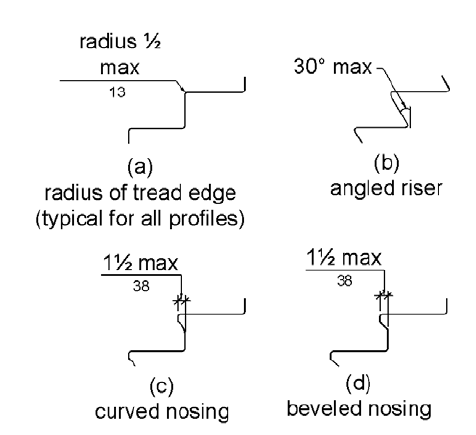Don't Let Title 24 Trip You Up

Beyond Accessibility: Unpacking California's Title 24 and Visually Contrasting Nosings
In the intricate world of stair treads and nosings, one often hears a lot about Title 24 and its association with brightly colored nosings embedded into concrete stairs. This design choice serves a crucial purpose, making it easier for the visually impaired to identify the leading edge of a stair tread. However, there is a common misunderstanding that California Title 24 pertains solely to the accessibility aspect of the California Building Code. In reality, Title 24 encompasses a much broader spectrum, composed of 12 distinct "Parts," including the Administrative Code, Building Code, Mechanical Code, and Fire Code, among others. In essence, Title 24 represents the comprehensive California Building Standards Code, reaching far beyond accessibility considerations.
The Roots of Accessibility in Title 24
Nestled within the intricate framework of the 2019 California Building Code, Part 2, Volume 1, is Chapter 11B. This chapter houses the regulations that address Accessibility to Public Buildings, Public Accommodations, Commercial Buildings, and Public Housing. It is within this chapter that the importance of visually contrasting nosings becomes apparent. Section 11B-504.4.1 stands as a testament to California's commitment to inclusivity:
"Contrasting Stripe. Interior stairs shall have the upper approach and lower tread marked by a stripe providing clear visual contrast. Exterior stairs shall have the upper approach and all treads marked by a stripe providing clear visual contrast."
This section goes into meticulous detail, explaining the precise requirements for the stripe's characteristics and placement on the stair tread to ensure compliance.
National Synergy: ADA Standards and Visual Contrast
The focus on visual contrast at the leading edge of stair nosings resonates not only within the confines of  California's Title 24 but extends to a broader national framework as well. The 2010 ADA Standards, housed under the General Site and Building Elements section, also emphasize the significance of visually contrasting nosings. Advisory 504.4 Tread Surface brings this into the spotlight, stating,
California's Title 24 but extends to a broader national framework as well. The 2010 ADA Standards, housed under the General Site and Building Elements section, also emphasize the significance of visually contrasting nosings. Advisory 504.4 Tread Surface brings this into the spotlight, stating,
"Consider providing visual contrast on tread nosings or at the leading edges of treads without nosings so that stair treads are more visible for people with low vision."
This advisory reflects a harmonious synergy between state and federal regulations, working in tandem to enhance accessibility and safety for all individuals, regardless of their visual capabilities.
In-Depth Insights: The Art of Visual Contrast
To fully appreciate the impact of visually contrasting nosings, it's essential to delve into the intricacies of this design element. These bright, conspicuous stripes are strategically positioned on the leading edge of stair treads. Their vivid color provides a stark contrast against the surrounding stair material, which is typically a neutral shade like concrete or wood. This contrast plays a pivotal role in ensuring that individuals with low vision or visual impairments can readily identify the edge of the stair, minimizing the risk of tripping or stumbling. The careful placement and design of these stripes are not just a matter of compliance but are an embodiment of a commitment to inclusivity and safety.
Beyond Compliance: A Necessity for Inclusivity
While Title 24 and ADA Standards offer regulatory guidance, the significance of visually contrasting nosings extends far beyond mere compliance. These design elements serve as a symbol of our dedication to creating spaces that are accessible, safe, and inclusive for everyone. They stand as a testament to our commitment to breaking down barriers and fostering an environment where individuals of all abilities can navigate public spaces with confidence.
Title 24's connection to brightly colored nosings in staircases is just one facet of a much broader and intricate code. It exemplifies California's dedication to creating buildings and spaces that are accessible to all, regardless of their abilities. The collaboration between state and federal regulations on visual contrast ensures that inclusivity and safety are at the forefront of architectural and design considerations, reminding us that creating a more accessible world is a shared responsibility.
Nystrom understands the complexities involved in constructing safe, code compliant stairways. We offer a full line of stair treads and nosings that will meet the California Building Code and ADA requirements. For more information on Nystrom Stair Treads and Nosings, please visit www.nystrom.com.




